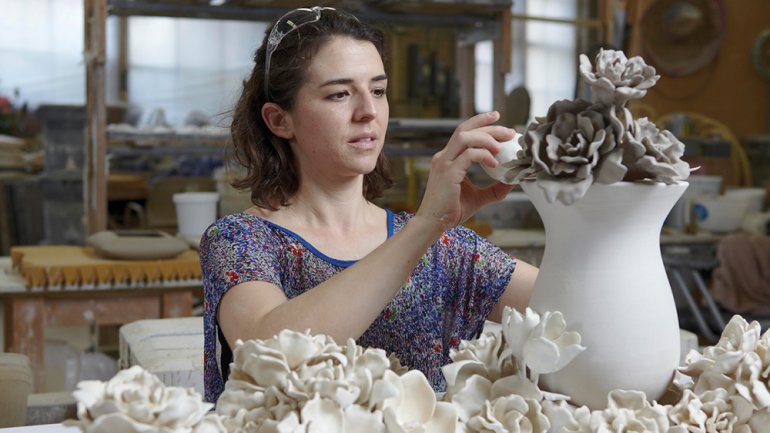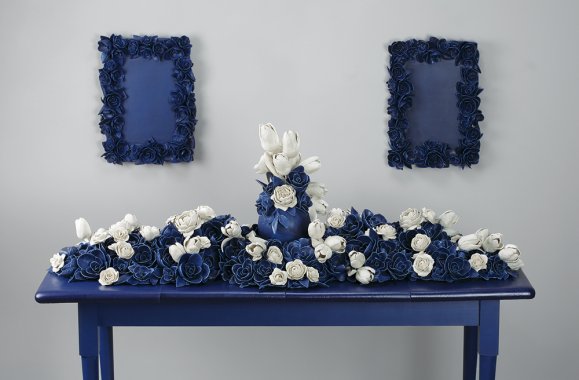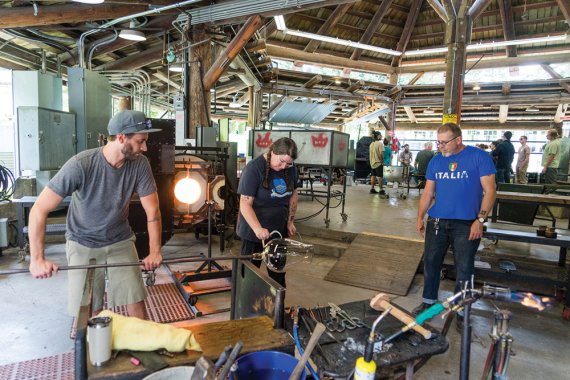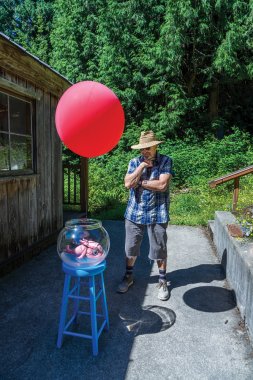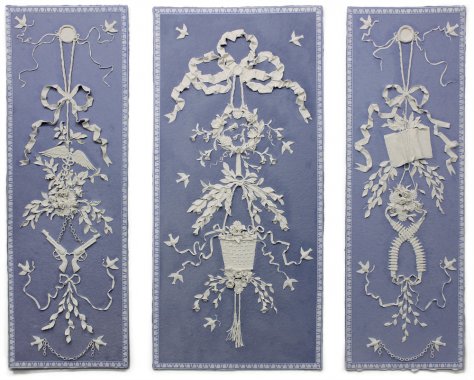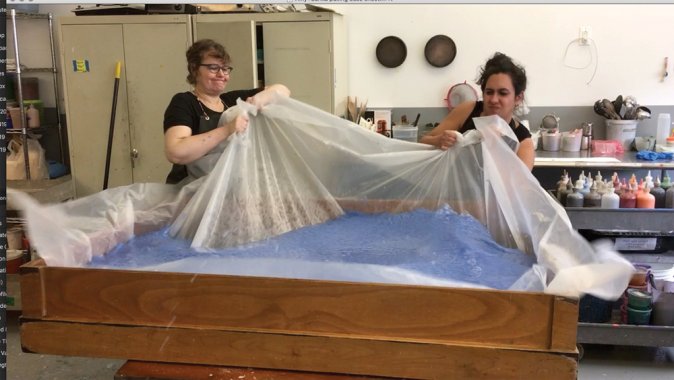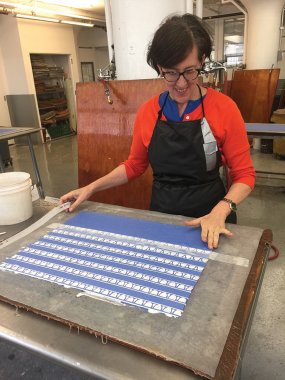Experimental Spaces
Experimental Spaces
What if you have an idea for an artwork inspired by Wedgwood ceramics, but you want to make it with paper pulp? Or if you know how to sculpt in clay, but want to make a fishbowl in glass? What if you dream of crafting pillows in porcelain? Artist residencies often attract medium-specific makers who want to spend time doing exactly what they do best, perhaps teaching workshops or giving demonstrations. But what about artists who want to explore something they’re not an expert in? Where the smorgasbord of formal, multidisciplinary art education ends, specialized residency programs begin, offering artists a chance to learn new disciplines and expand their skill sets.
The 1970s was the golden age of artist residencies. Three monumental programs in craft mediums, each detailed in this article, were founded within a few years of one another: the Arts/Industry Program at John Michael Kohler Arts Center, established in 1974 in Sheboygan, Wisconsin; the Pilchuck Glass School, set up in 1971 in Stanwood, Washington; and Dieu Donné, incorporated in 1976 in New York City.
At first glance, the programs seem to have few similarities: Kohler’s factory setting is massive and industrial, while Pilchuck is rural, and Dieu Donné is perched in the heart of the Brooklyn Navy Yard. But all three programs offer artists at different stages of their careers the time, space, and support to take valuable risks by working in a material or technique they haven’t yet mastered, or that may be totally new to them.
Kohler
Ceramic Expertise on a Grand Scale
“Kohler Co.” is a name many recognize from kitchens and bathrooms across the country. But the company, established in 1873, made cast iron products – equipment for farms and local furniture factories, even decorative urns and crosses for cemeteries – before establishing itself as a manufacturer of ceramic fixtures.
In 1966, the Kohler Foundation donated the family’s historic home to the Sheboygan Arts Foundation. Over the years, it has expanded into a robust art museum, with dance, music, and theater programming, called the John Michael Kohler Arts Center. It’s also the administrative headquarters of the Arts/Industry residency program, which began in 1974 when Ruth DeYoung Kohler, longtime director of the arts center and granddaughter of the founder, invited potters to make work within the factory. Her brother Herbert, the company’s CEO at the time, gave the endeavor his blessing. “Herb calls me his crazy sister,” she shared with American Craft in 2014, “always coming up with new ideas.”
And it was a good idea: Since that first year, when Jack Earl and Tom LaDousa delighted factory staff by making sculptures out of Kohler urinals and toilets, the Arts/Industry program has welcomed more than 500 makers to its unique facility to work in metal, ceramics, or enamel, with the aid of Kohler factory experts and engineers in the Pottery and Foundry facilities.
Competition is fierce for the 12 three-month residencies offered each year. Program director Faythe Levine says it attracts an intriguing pool of candidates – “from traditional craftspeople to performance artists” – since they don’t need experience in ceramics or metal to apply.
Artist Giselle Hicks says that the industrial knowledge she learned from Arts/Industry during her two residencies there had a big impact on the projects she produced. Hicks, who has an MFA from the New York State College of Ceramics at Alfred University, is already an expert in clay. But she didn’t have much mold-making experience, and working at Kohler as a resident in 2005 and 2012 helped deepen her understanding of what she could – and couldn’t – achieve technically.
The company’s heritage as a manufacturer of domestic fixtures made it the perfect place for her first residency project. Intrigued by the social rituals and connections formed in bedrooms and dining rooms, she set her sights on creating a piece that abstracted the planar forms of both a mattress and a dining table. But she didn’t want to make a monumental version of those things. “I wanted to achieve scale in my work through the multiple,” she says. “I wanted to make something that the viewer understood with their body – objects that were familiar enough to draw the viewer to them, strange enough to hold their attention at a distance.” Working with Monty Stauffer and other Arts/Industry technicians and associates, Hicks built molds and perfected her casting and glazing techniques, resulting in several abstract works, built of multiples, that evoke the bed and the table at once.
When Hicks returned to Arts/Industry for a second residency in 2012, she aimed to create a table with a floral surface pattern that appears to bloom into three-dimensional ceramic bouquets. This project proved too challenging to complete during her residency, but she was able to take the knowledge gleaned from her experiments there and try again. The results were two tables and a series of wall tiles that were inspired by a tapestry. “You don’t really know if something works or not until you finish the thing,” Hicks, now 40, says, grateful that at Arts/Industry she had the time, materials, and access to expertise she needed to explore her ideas.
Pilchuck
A Magnet for the “Glass-Curious”
Like Arts/Industry, the Pilchuck Glass School in northeast Washington attracts artists who are eager to dive metaphorically into a specific material. But where Kohler allows makers to use and learn about industrial processes, Pilchuck is deeply rooted in studio craft. Established in 1971 by artist Dale Chihuly and philanthropists John H. Hauberg and Anne Gould Hauberg, the program was initially designed as a summer workshop. Nearly 50 years later, it’s established as a major center for glass art instruction and a magnet for glass and glass-curious artists alike.
Pilchuck offers two residencies that artists can apply for. The John H. Hauberg Fellowship, a 12-day program held each spring, is designed for groups of up to six artists to work together on a themed project. (The artists tend to work in visual media, but the fellowship is open to writers, performers, curators, and critics, too.) Emerging Artist in Residence (EAiR), the second program, is designed for glass artists in earlier stages in their careers, and Pilchuck welcomes a small juried group of them each fall.
Artistic director Benjamin Wright notes that although Pilchuck’s superb facility is a big draw for artists from all over the world, so are its setting and the people who work there. “Residents can expect a talented, motivated, and curious cohort with which to explore the material,” he says. “Coming to Pilchuck, situated on a magical plot of land surrounded by beautiful forests, is a much-deserved break from the rigors of life. It allows artists to recharge their energy and focus entirely on their studio practices.”
For Doug Jeck, who teaches ceramics at the University of Washington in Seattle, Pilchuck was relatively close geographically – about 50 miles as the crow flies – but being an artist in residence there last summer gave him access to a whole other world.
Jeck, who works primarily in figurative ceramics but experiments in mixed-media works incorporating video, arrived at Pilchuck with an idea for what he describes as “site-specific, photographic works with basic glass elements,” but notes that he wanted to work “spontaneously.” With the aid and instruction of skilled technicians, he was able to make pieces that he later arranged into surrealistic scenes and photographed, such as a fishbowl (for his own Dr. Seuss-inspired stuffed fish), several versions of Man Ray’s Gift (the famous 1921 sculpture of a flatiron with tacks glued to it), and a football helmet.
Dieu Donné
Playing with Paper
Dieu Donné was founded in 1974 by printmaker and book artist Susan Gosin while she was a graduate student at the University of Wisconsin, Madison. When she moved to New York City in 1976, she incorporated it as Dieu Donné Press and Paper with fellow artist Bruce Wineberg, and they began producing limited-edition letterpress books and collaborating with artists wanting to work with paper. Today, Dieu Donné is a nonprofit education studio (the Press was incorporated separately in 1988 to focus on producing fine books) offering two residency programs that include the opportunity to work with a “master collaborator.”
“Our residents generally have little or no experience making paper,” says Tatiana Ginsberg, co-director of artistic projects and one of Dieu Donné’s master collaborators. The Lab Grant residency is invitation-only and tends to be awarded to well-known artists in other mediums, including former residents Ann Hamilton, Do-Ho Suh, Nari Ward, and Nicole Eisenman. It provides “a chance to experiment and discover freely” outside of one’s established practice, says Ginsberg. The juried Workspace residency, however, is designed for emerging artists based in New York state. Like Lab Grant participants, Workspace artists are typically not paper-makers, and are invited to Dieu Donné in part to experiment.
Artist Susan Hamburger came to her 2018 Workspace residency at Dieu Donné with a vague notion of what she wanted to make. In her painting, papier-mâché, and collage practice, she often references 18th- and 19th-century prints and ceramics as well as Neoclassical architecture and ornamentation. In particular, she has been drawn to Josiah Wedgwood’s Jasperware, a line of fashionable ceramics, decorated with applied ornaments, that debuted in the 1770s.
“My goal was to go beyond simply translating my work into handmade paper,” she says, “and to create something that, without this opportunity, I would have otherwise been unable to make.” Working with master collaborator Amy Jacobs, she was able to complete a Jasperware-inspired triptych with pressed paper borders and relief elements of casting cotton that she either hand sculpted or built with molds.
Hamburger credits the success of her residency to having room to work out her ideas as well as the ability to collaborate with an expert. It’s a sentiment that reflects how residencies provide valuable time and space for artists of all levels to experiment, fail, and grow. “The first day was all about ruling things out by trial and error, with a number of comical snafus, including a mold that didn’t survive the press,” Hamburger says of her time at Dieu Donné. “But from that process of elimination and mishaps came the idea for the final piece.”
Studio Adventures
Residencies provide makers vital opportunities to focus on a project, take risks, gain skills, and grow. This small sampling represents some of the dynamic experiences open to makers of all levels and interests across the US.
CA/San Francisco and three other West Coast locations
Recology
Situated at a waste disposal, recycling, and compost facility, Recology Artist in Residence (AIR) Programs invite artists to use discarded materials in new ways that foster reflection on individual and societal consumption practices. Founded in San Francisco in 1990, the program now operates in four cities: San Francisco, Seattle, and Portland and Astoria, both in Oregon. Residencies are four to five months long.
CA/Woodside
Djerassi
Located on a 583-acre ranch in the Santa Cruz Mountains overlooking the Pacific Ocean, this rural residency is awarded to artists in fields including visual arts, music composition, science, and choreography. There are six residency sessions per year, four to five weeks in length, with one residency specifically devoted to the intersection of art and science.
GA/Rabun Gap
Hambidge Center
The Center sits on 600 heavily wooded acres, with streams, waterfalls, walking trails, and wildflower meadows. The area is a national repository for native plants and a protected site for endangered species. By welcoming applicants from a variety of fields, such as ceramics, design, and culinary arts, Hambidge also presents opportunities for creative cross-pollination. Residencies typically last between two weeks and two months.
ME/Deer Isle
Haystack Mountain School of Crafts
For two weeks each year, the well-known Haystack Mountain School of Crafts provides about 50 participants studio time and the opportunity to be part of a supportive arts community. For those 14 days, participants can choose to work in one of the six technician-staffed studios (ceramics, fiber, graphics, iron, metals, and wood) or move among them.
MN/Minneapolis
Northern Clay Center
One of the nation’s premier clay centers offers residencies for ceramic artists at different stages of their careers. Up to four emerging artists are given NCC studio space for a year to develop their work. The McKnight Artist Residency for Ceramic Artists supports up to four mid-career artists with three months of studio space and $6,000.
NE/Marquette
Art Farm
In exchange for help in renovating and maintaining its buildings and grounds (approximately 12 hours per week), Art Farm offers accommodation and studio space in a quiet, rural environment. The opportunity is ideal for those who are resourceful, self-motivated, and up for experiencing Nebraska farm life. Residencies can be of any duration between June and November, with accommodations available for up to 12 residents at a time.
NE/Omaha
Bemis Center for Contemporary Arts
Located in downtown Omaha, the Bemis Center provides residents in a variety of fields – from furniture-making to textiles to sound art – with large private live/work studios to use for three months. The center also provides financial support, technical and administrative assistance, and opportunities for intellectual discourse. Facilities include a communal residency installation room, a fabrication space, a research library, and a wide array of tools and equipment for ceramics, woodworking, welding, and metalworking.
NJ/Layton
Peters Valley School of Craft
These two- to four-week residencies offer a chance to create work in the Delaware Water Gap National Recreation Area, operated by the National Park Service, where Peters Valley School of Craft is located. The park covers 67,000 acres of land, trails, beaches, and waterfalls, and borders 40 miles of the Delaware River. Each resident works in one of the school’s fully equipped studios: ceramics, blacksmithing, fiber art, fine metals, or woodworking.
NM/Santa Fe
Artist-in-Residence (A-I-R) Institute of American Indian Arts
Two residencies for tribally enrolled Native American or First Nations artists from the Southwest, Northwest, Upper Midwest, Alaska, or British Columbia grant access to the Institute’s state-of-the-art equipment and workshops, including its fabrication lab (offering 3D printing and a waterjet cutter) and photography and printmaking studios. One residency is specifically for artists creating large sculpture; the other is for artists working in contemporary or historic Native and First Nations art forms, including beadwork, quillwork, weaving, installation art, and jewelry.
NY/Brooklyn
Dieu Donné
Two residencies, each divided into a series of short visits over the course of a year, help artists finesse their papermaking skills under the guidance of masters. As of 2018, a partnership with the Brooklyn Grange rooftop farm also provides access to a working urban farm for four Dieu Donné residents whose work relates to ecology and the environment.
NY/Wassaic
Wassaic Project
This program offers nine to 12 artists the opportunity to live and work in the heart of a rural New York community for at least a month. In the winter, artists in residence work at the Old Hotel in Maxon Mills, where 19th-century hotel rooms have been converted into small studios. In the summer, residents work under wood-beamed ceilings at the Luther Barn in refurbished livestock pens. Round-the-clock access to a ceramics studio and the print and wood shops is also provided.
NC/Greensboro
Elsewhere Artist Collaborative
Housed in a former thrift shop, Elsewhere’s Living Museum asks artists in residence to create site-specific work in two to four weeks that explores the environment, neighborhood communities, cultural histories, and social systems. Residents have access to the museum’s collection of textiles, toys, books, bric-a-brac, clothes, and consumer technologies – and they’re not allowed to take their work with them.
NC/Penland
Penland School of Craft
At Penland, resident artists are self-supporting craftspeople who live and work in the school’s close-knit community for three years. Interaction between residents and students is encouraged; residents are asked to host an open house during each Penland session and to maintain an open-door policy at their studios. Applicants are highly encouraged to visit the school before applying.
OK/Tulsa
Tulsa Artist Fellowship
This merit-based, one-year fellowship awards artists, writers, musicians, and other creatives at various career stages an unrestricted $20,000 award, as well as free housing and studio space in downtown Tulsa’s arts district. Designated spots are reserved for Alaska Native, Native American, and Native Hawaiian arts practitioners.
PA/Philadelphia
RAIR
Two programs at this large recycling facility provide opportunities for makers to work at the intersection of art, industry, and sustainability. The Standard program (four to six weeks) is a studio-based residency, while the Biggie Shortie (two to four weekends), is project-based, challenging makers to complete a big project in a short amount of time. Both programs provide artists on-site access to materials in Revolution Recovery’s waste stream, construction equipment, a fully equipped studio space, and the help and support of RAIR staff. The entire 3.5-acre facility is open to artists as an expansive project space to develop and present ambitious experimental work.
TN/Gatlinburg
Arrowmont School of Arts and Crafts
Five community-oriented residents are selected annually to participate in Arrowmont’s 11-month program, which is designed to provide preprofessional, self-directed artists time and space to develop a major body of work. Artists are given a monthly stipend in exchange for 10 hours of work per week, and are provided with a private bedroom in shared housing, and a private climate-controlled studio. Resident artists are encouraged to sit in on lectures and demonstrations.
TX/Houston
Houston Center for Contemporary Craft
This program supports makers at all stages of their careers working in clay, fiber, glass, metal, and wood. Each resident is provided 24/7 access to a private 200-square-foot studio and receives a $600 monthly stipend that includes a housing and materials allowance. Residencies are offered in three-, six-, nine-, and 12-month stints.
WA/Stanwood
Pilchuck Glass School
Pilchuck offers two residency programs that artists of all mediums can apply for: the Emerging Artist in Residence Program and the John H. Hauberg Fellowship for established artists. Emerging artists in residence receive a $1,000 stipend, lodging, and access to Pilchuck’s studios. Hauberg fellows work on a theme, over 12 days. Pilchuck’s artistic director also invites select artists, designers, and creative thinkers to participate in summer residencies.
WI/Sheboygan
John Michael Kohler Arts Center
Every year, the Arts/Industry program welcomes 12 artists into Kohler Co.’s pottery and foundry workshops to experiment in clay, enamel, and metal with the assistance of Kohler Co. technicians. During their three-month stints, residents also learn about industrial processes.
WY/Clearmont
Ucross Foundation Residency Program
Each year, this High Plains residency offers about 85 artists accommodations, uninterrupted time, and work space. At any one time, there are up to 10 individuals in residence: a mix of visual artists, writers, and composers. Four 400-square-foot studios are available for visual artists. Typical residencies are one month long, but can vary from two to six weeks. Ucross’ Fellowship for Native American Visual Artists offers a four-week residency plus a $2,000 stipend.
Nationwide
National Parks Arts Foundation
These residencies of varying lengths are a draw for makers of all experience levels, with special appeal to adventure seekers and fans of history and nature. Applications are accepted directly through individual parks across the US, including places like Hawaii Volcanoes National Park and Dry Tortugas National Park in the Florida Keys.
